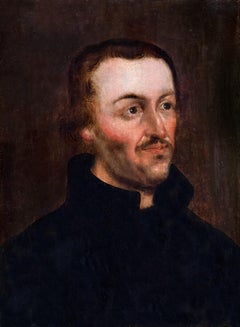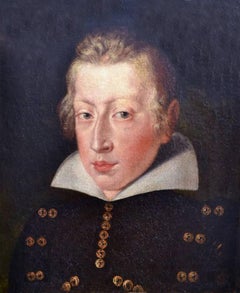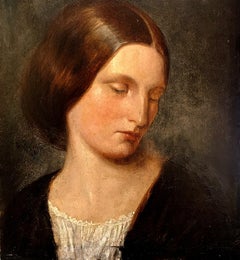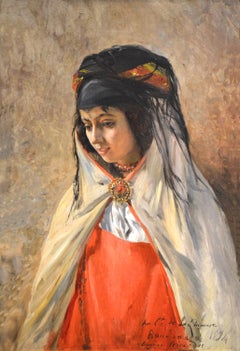Want more images or videos?
Request additional images or videos from the seller
1 of 4
Mid 16th Century English SchoolPortrait of Thomas Cranmer, Archbishop of Canterbury, Mid 16th Century Oil
$10,746.23List Price
About the Item
- Creator:Mid 16th Century English School (1501 - 1550, English)
- Dimensions:Height: 12.5 in (31.75 cm)Width: 8 in (20.32 cm)
- More Editions & Sizes:1 of 1Price: $10,746
- Medium:
- Period:
- Condition:
- Gallery Location:London, GB
- Reference Number:1stDibs: LU52412163562
About the Seller
5.0
Vetted Professional Seller
Every seller passes strict standards for authenticity and reliability
Established in 2007
1stDibs seller since 2014
83 sales on 1stDibs
Typical response time: 4 hours
Authenticity Guarantee
In the unlikely event there’s an issue with an item’s authenticity, contact us within 1 year for a full refund. DetailsMoney-Back Guarantee
If your item is not as described, is damaged in transit, or does not arrive, contact us within 7 days for a full refund. Details24-Hour Cancellation
You have a 24-hour grace period in which to reconsider your purchase, with no questions asked.Vetted Professional Sellers
Our world-class sellers must adhere to strict standards for service and quality, maintaining the integrity of our listings.Price-Match Guarantee
If you find that a seller listed the same item for a lower price elsewhere, we’ll match it.Trusted Global Delivery
Our best-in-class carrier network provides specialized shipping options worldwide, including custom delivery.You May Also Like
c. 1920s German Portrait Signed B. Zickler
Located in New York, NY
B. Zickler
Msrienbad (Marienbad?), c. 1920s
Oil on wood panel
13 1/4 x 10 1/4 in.
Framed: 17 x 14 x 1 in.
This painting was likely executed by a German artist, who is only known to ...
Category
1920s Modern Portrait Paintings
Materials
Oil, Wood Panel
Woman Reading by JOZEF ISRAËLS - Dutch painter, Hague School, portrait art
By Jozef Israëls
Located in London, GB
Woman Reading by JOZEF ISRAËLS (1824-1911)
Oil on Panel
21 x 12.5 cm (8 1/4 x 4 15/16 inches)
Signed lower right
Executed circa 1870
Artist biography
Du...
Category
19th Century Academic Figurative Paintings
Materials
Oil, Wood Panel
$9,500
H 8.27 in W 4.93 in
Tiger Portrait Pop Art with Floral Mandala in Chains by British Graffiti Artist
By Chris Pegg
Located in Preston, GB
Tiger Portrait Pop Art with Floral Mandala in Chains by British Urban Graffiti Artist, Chris Pegg, using red, pink & turquoise. Chris Pegg is a self-taught Street Artist producing ar...
Category
2010s Pop Art Portrait Paintings
Materials
Board, Wood Panel, Wood, Paint, Stencil, Pencil, Felt Pen, Acrylic, Spra...
$3,251 Sale Price
20% Off
H 24 in W 24 in D 2 in
Longing
Located in Colorado Springs, CO
Original oil painting on panel by artist Tanner Steed. Framed.
Category
21st Century and Contemporary Contemporary Portrait Paintings
Materials
Oil, Panel
The Blood Of Christ, The Milk Of The Madonna, 16th Century
Located in Blackwater, GB
The Blood Of Christ, The Milk Of The Madonna, 16th Century
circle of Adriaen Isenbrandt (1480-1551)
Huge 16th Century Flemish old Master depiction of...
Category
16th Century Portrait Paintings
Materials
Oil, Wood Panel
St. Vincent Ferrer Preaching to the People of Salamanca
Located in New York, NY
Provenance:
Private Collection, New Jersey
The present painting depicts Saint Vincent Ferrer preaching from a raised pulpit to a group of seven peopl...
Category
15th Century and Earlier Renaissance Figurative Paintings
Materials
Oil, Wood Panel
$17,500
H 11.75 in W 8 in
Portrait of a Man
Located in New York, NY
Provenance:
with Leo Blumenreich and Julius Böhler, Munich, 1924
Dr. Frederic Goldstein Oppenheimer (1881-1963), San Antonio, Texas; by whom given to:
Abraham M. Adler, New York, until 1985; thence by descent to the present owners
While old inscriptions on the verso of this panel propose its author to be Hans Holbein and the sitter Sir John More—a lawyer, judge, and the father of Sir Thomas More—this fine portrait has long been recognized to be by a Flemish hand. Max Friedländer gave the painting to Bernard van Orley (1487/1491 – 1541) in 1924, but did not include it in the volume dedicated to the artist in his Early Netherlandish Paintings...
Category
16th Century Old Masters Portrait Paintings
Materials
Oil, Panel
Portrait of a girl with a rose and a red coral necklace (c. 1631)
Located in Amsterdam, NL
David Finsonius (Veere 1597- Bergen op Zoom 1646/1648)
Portrait of a girl with a rose and a red coral necklace
With traces of the artist’s signature and annotated AETATIS S.V. 2 1⁄2 Ao 1631
Oil on panel, H. 104.5 x 79.5 cm
Provenance:
Purchased by Jonkheer Helenus Marius Speelman (1857-1909), Kasteel de Wittenburg; thence by
descent
The work shows a strong resemblance to a portrait by Finsonius in the North Brabant Museum. This
signed and dated "Girl with Basket and Cherries" (Inv. 15529), was painted just a year later, in 1632.
Not only are the paintings remarkably similar in overall size and format, in painting style, and in the
positioning of the girls in full length in their white lace dresses. They are also connected by the
iconographic scheme of the respective coral necklaces, each with a gold memorial medal hanging
from it. Although they are of course individuals, the faces are very similar in their depictions of
features such as eyes, nose, and lips. This points to the same technique applied by the same painter.
Finally, the handwriting is almost the same on the works by Finsonius known so far.
About the painter, David Finson named 'Finsonius' (related to the better-known Louis Finson...
Category
17th Century Dutch School Portrait Paintings
Materials
Oil, Wood Panel
$102,284
Free Shipping
H 41.15 in W 31.11 in D 1.58 in
Young Girl
Located in Greenville, DE
Titled on the back, "Head of Small Girl". Painted in a impressionist style. Labeled on the back Eloise Waggoner 24 Wilmont Mews, West Chester, PA, 19380. ...
Category
20th Century Impressionist Portrait Paintings
Materials
Oil, Wood Panel
18th Century Venetian School Portrait of a Bishop Oil on Panel Green Brown Black
Located in Sanremo, IT
Painting oil on panel measuring 40 x 30 cm without frame and 48 x 38 with frame representing a great bishop of the Venetian school from the first half of the 18th century.
Very curi...
Category
Early 18th Century Italian School Portrait Paintings
Materials
Oil, Wood Panel
$1,155 Sale Price
20% Off
H 15.75 in W 11.82 in D 1.19 in
More From This Seller
View AllPortrait of Philip Melanchthon
By German School
Located in London, GB
German School
17th Century
Portrait of Philip Melanchthon
Oil on panel
Image size: 9 x 12 inches (22.6 x 30.3 cm)
This charming portrait depicts Philip Melanchthon, the acclaimed Lu...
Category
17th Century Portrait Paintings
Materials
Oil, Wood Panel
Portrait of a Boy in a Black Tunic - Early 17th Century Oil
Located in London, GB
Flemish School, Early 17th Century
Portrait of a Boy in a Black Tunic
Oil on panel
Image size: 15¾ x 13⅛ inches
This accomplished portrait of an unknown boy in his early teens was p...
Category
17th Century Portrait Paintings
Materials
Oil, Panel
Portrait of a Mary Hardy (nee Sulman), Late 19th Century Victorian Oil
Located in London, GB
Slade School
Late 19th Century
Portrait of a Mary Hardy (nee Sulman)
Oil on panel
Image size: 8 x 7 inches
Contemporary frame
Provenance
Lady Town (Grandda...
Category
Late 19th Century Victorian Portrait Paintings
Materials
Oil, Panel
The Gold Brooch, Orientalist Oil Painting, Signed and dated 1894
By Eugene Alexis Girardet
Located in London, GB
Oil on panel, signed, dated and inscribed ‘Bou Saada, 1894’ lower right
Image size: 13 x 8 3/4 inches (33 x 22.25 cm)
Ornate Gilt frame
Euguene Alexis Girardet
A child prodigy, Gi...
Category
1890s Portrait Paintings
Materials
Oil, Panel
Portrait of a Young Man - 17th Century Portrait in Oil
By Pieter Harmensz Verelst
Located in London, GB
Circle of Pieter Harmensz Verelst
1618 - 1678
Portrait of a Young Man
Oil on oak panel
Image size: 7 ½ x 5 ¾ inches
Dutch ripple frame
Category
18th Century and Earlier Old Masters Portrait Paintings
Materials
Oil, Panel
Portrait of a Man, 17th Century Dutch Oil on Panel Portrait
By Cornelis Dusart
Located in London, GB
Circle of Cornelis Dusart
Dutch 1660 - 1704
Portrait of a Man
Oil on panel
Image size: 7¾ x 5¼ inches
Giltwood frame
Cornelis Dusart
Cornelis ...
Category
17th Century Old Masters Portrait Paintings
Materials
Oil, Panel
Recently Viewed
View AllMore Ways To Browse
Old French Portraits
Portrait Of A Beauty
17th Century Portrait Of A Gentleman
Bearded Painting
Captain Painting
Joshua Salami
Oil Painting 1820
Celebrity Painting
Oil Portrait Francis
Scottish Art Portrait
Victorian Girl Painting
Portrait Van Gogh
Antique Military Portraits
19th Century Portrait Child
Lace Framed Art
Portrait Woman Yellow
18th Century British Paintings
19th Century American Portrait Of A Lady



